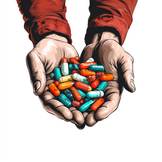What is the blue pill viagra and how does it treat erectile dysfunction?
- The "Little Blue Pill": Viagra
- The Mechanism of Action: Phosphodiesterase Type 5 (PDE5) Inhibitors
- How Viagra Works to Treat Erectile Dysfunction (ED)
- Common and Serious Side Effects of Viagra
- Comparing Viagra with Other PDE5 Inhibitors: Cialis, Levitra, Stendra, and Staxyn
- Alternative Treatments for ED and Consulting a Doctor
- Contraindications: Nitrates for Chest Pain and Guanylate Cyclase Stimulators for Pulmonary Hypertension

The "Little Blue Pill": Viagra
Often colloquially referred to as the "little blue pill," Viagra has become a household name since its approval by the U.S. Food and Drug Administration in 1998. Its primary function is to combat erectile dysfunction (ED) - a common condition in men that affects the ability to achieve and maintain an erection suitable for sexual intercourse. The active ingredient in Viagra is sildenafil, a type of medication classified as a phosphodiesterase type 5 (PDE5) inhibitor.
The Mechanism of Action: Phosphodiesterase Type 5 (PDE5) Inhibitors
PDE5 inhibitors, such as sildenafil, work by targeting a specific enzyme in the body known as phosphodiesterase type 5. This enzyme plays a key role in the regulation of blood flow to the penis. When it is inhibited, the muscles in the penis relax, allowing blood to flow more freely and leading to an erection. This process is crucial for individuals with ED who struggle to achieve or maintain an erection without such intervention.
How Viagra Works to Treat Erectile Dysfunction (ED)
When sexually stimulated, a man's body releases nitric oxide into the tissues of the penis. This leads to the production of cyclic guanosine monophosphate (cGMP), which causes the muscles in the penis to relax and the blood vessels to dilate. The enzyme PDE5 breaks down cGMP. When Viagra is consumed, it inhibits the action of PDE5, allowing cGMP to accumulate and persist longer. The effects encourage greater blood flow to the penis, enabling the user to achieve an erection in response to sexual stimulation.
To answer a couple of common queries, Viagra typically starts working within 30 to 60 minutes, and its effects can last up to four hours. However, this doesn't mean you will have an erection for this entire duration; Viagra aids in achieving an erection in response to sexual stimulation. Also, Viagra does not influence sexual desire or arousal directly. After climax, a man’s erection typically subsides, but Viagra could help with achieving another erection quicker than usual.
Common and Serious Side Effects of Viagra
While Viagra is generally safe to use under a doctor's supervision, it can cause side effects. Common ones include headaches, facial flushing, indigestion, nasal congestion, and impaired vision. On rare occasions, serious side effects may occur, including priapism (an erection that doesn't go away, which can cause damage to the penis) and sudden vision loss. It is crucial to discuss these side effects with a healthcare provider, who can advise whether Viagra is a safe option.
Comparing Viagra with Other PDE5 Inhibitors: Cialis, Levitra, Stendra, and Staxyn
Viagra is one of several PDE5 inhibitors available. Other options include Cialis (tadalafil), Levitra (vardenafil), Stendra (avanafil), and Staxyn (also vardenafil). Each of these medications works similarly but differs in aspects like how long they take to start working, how long their effects last, and their side effects. Cialis, for instance, may work faster than Viagra and its effects can last up to 36 hours, but it may also have different side effects.
Alternative Treatments for ED and Consulting a Doctor
There are several alternative treatments for ED, such as other medications, lifestyle changes, vacuum erection devices, or surgery. Some people may also find natural or herbal remedies helpful. However, it's vital to discuss these options with a healthcare provider before trying them. A doctor can help understand the underlying cause of ED and recommend the most appropriate treatment.
As of my knowledge cutoff in September 2021, Viagra requires a prescription in the United States. Some countries may have it available over the counter, but it's essential to consult a healthcare provider before using Viagra to understand the potential risks and benefits.
Contraindications: Nitrates for Chest Pain and Guanylate Cyclase Stimulators for Pulmonary Hypertension
Certain people should not take Viagra.
This includes individuals who take nitrates for chest pain or guanylate cyclase stimulators for pulmonary hypertension, as combining these medications with Viagra could cause a sudden and dangerous drop in blood pressure.Always disclose your full medical history and all medications you're taking to your healthcare provider before beginning a new medication.
In essence, Viagra, or the "little blue pill," works to treat ED by inhibiting the PDE5 enzyme, enhancing blood flow to the penis, and enabling the user to achieve an erection in response to sexual stimulation. However, like all medications, it comes with potential side effects and may not be suitable for everyone. Always consult with a healthcare provider before starting Viagra or any other treatment for ED.



